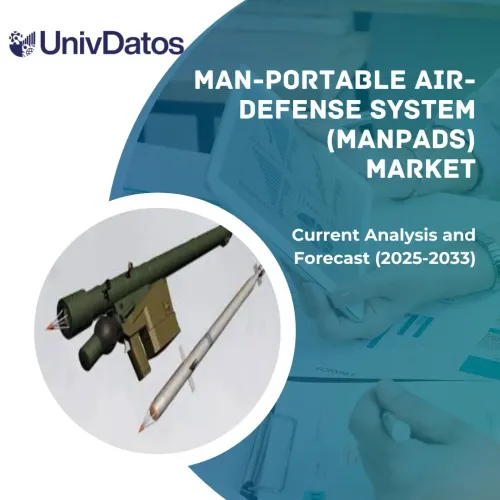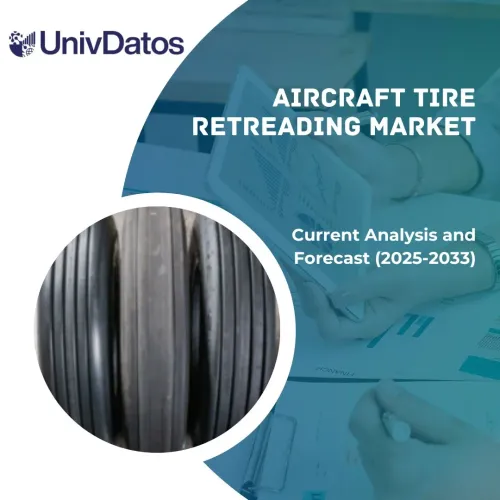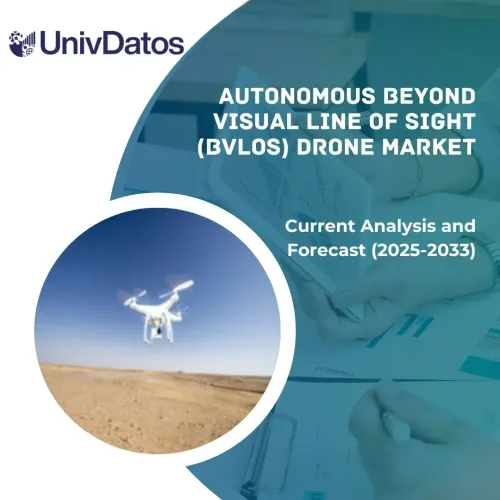- Home
- About Us
- Industry
- Services
- Reading
- Contact Us
Aircraft LED Market: Current Analysis and Forecast (2024-2032)
Emphasis on Aircraft Type (Commercial Aircraft, Military Aircraft, and Others), Application (Interior LED {Cabin Lights, Reading Lights, Emergency Exit Lights, and Others} and Exterior LED {Navigation Lights, Landing Lights, Anti-Collision Lights, and Others} ), End-user (OEM and Aftermarket); and Region/Country
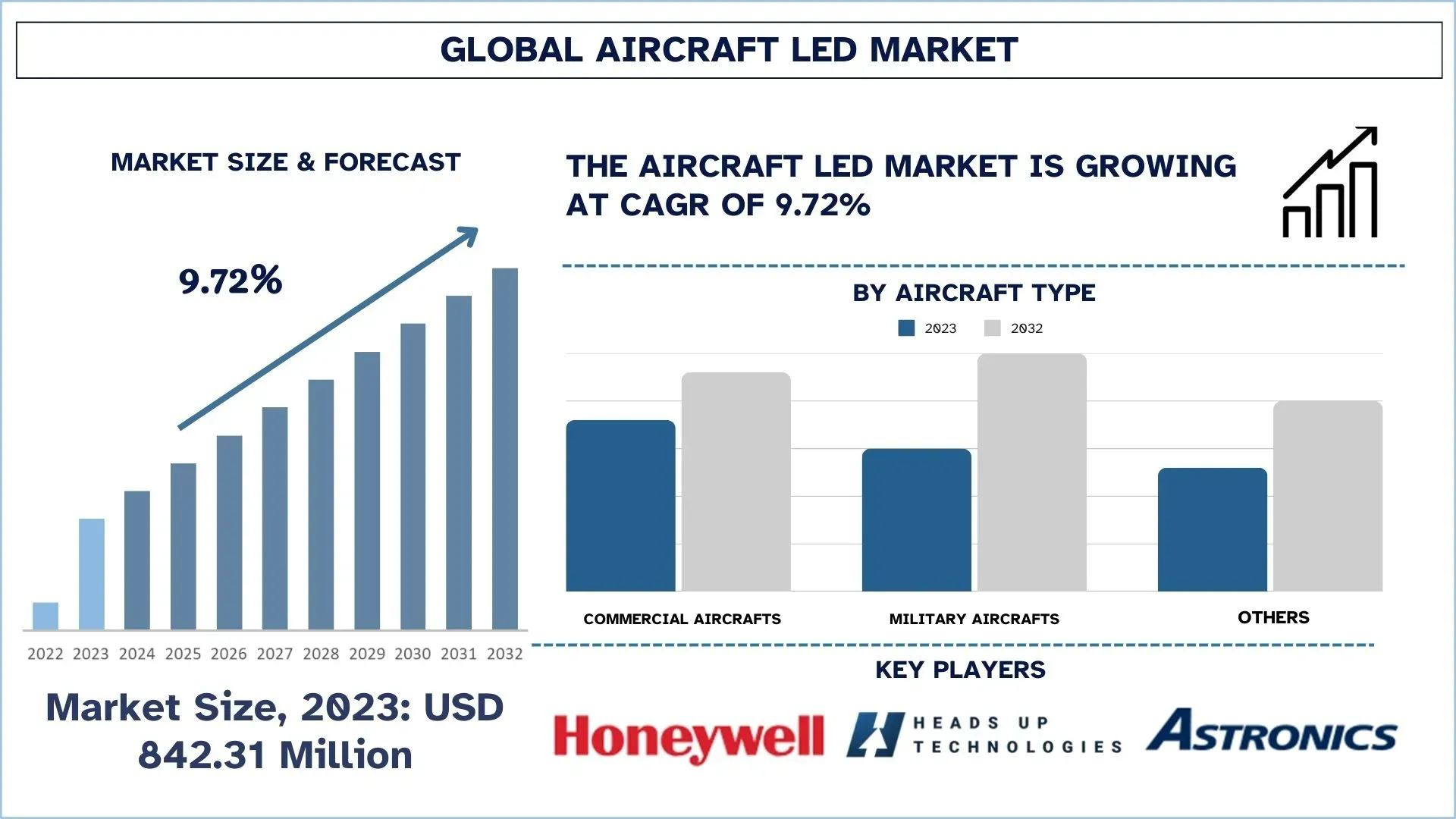
Aircraft LED Market Size & Forecast
The Aircraft LED Market was valued at approximately USD 842.31 million in 2023 and is expected to grow at a substantial CAGR of around 9.72% during the forecast period (2024-2032) owing to increasing demand for energy-efficient and durable lighting solutions in the aircraft industry.
Aircraft LED Market Analysis
Light-emitting diode (LED) lighting systems are widely used for aviation purposes by the aircraft industry for interior as well as exterior illumination applications. The modern illumination system substitutes traditional incandescent and fluorescent lighting with lighting fixtures that bring high energy efficiency, durability, and superior functioning. The interior LED lighting system includes a cabin illumination system with reading lamps, and cockpit lighting which uses adjustable mood settings for better passengers' comfort and jet lag reduction. The complete set of exterior navigation lights such as landing lights, taxi lights, and anti-collision lights functions through LED illumination to enhance visibility while boosting safety levels and resisting harsh conditions. Additionally, operational costs decrease for airlines as LEDs require less maintenance and generate less heat as compared to other classic lighting systems. The lightweight design of these systems helps improve the aircraft's fuel efficiency. These days, modern aviation relies extensively on aircraft LED systems which implement adaptive brightness controls, and customizable colors as well as IoT capabilities through smart lighting advancements.
The aircraft LED market is expanding because the aviation industry demands durable and lightweight lighting solutions with energy-efficient performance. In recent years, the airline industry has adopted LED technology to minimize fuel usage while cutting expenses and producing more efficient lighting which improves passenger comfort. Moreover, the FAA along with EASA promotes environmentally friendly solutions to accelerate LED adoption through their regulatory efforts. The market for LED lighting systems experiences continuous growth because of rising new aircraft production rates for commercial, and private use as well as military needs and retrofit activities for existing fleets. The advancements in smart lighting technology through IoT-enabled human-centric solutions support safety improvement, operational efficiency as well as passenger comfort. Additionally, sustainable aviation and carbon reduction strategies work as primary forces that drive market expansion. Recent LED technological developments in brightness performance, with adaptive control systems, and UV-disinfection capabilities are expected to drive considerable growth for aircraft LED systems during aircraft manufacturing and subsequent aftermarket operations.
Aircraft LED Market Trends
This section discusses the key market trends influencing the various segments of the aircraft LED market as identified by our research experts.
OLED and Micro-LED Adoption
OLED (Organic Light-Emitting Diode) and Micro-LED display technology are significant future trends for aircraft illumination because they provide better performance along with design adaptability. The use of OLED panels creates thin flexible luminous components that are integrated inside walls ceilings and seat panels leading to better aesthetics and lower aircraft weight. When it comes to both indoor and outdoor applications Micro-LEDs outperform traditional LEDs because they offer superior brightness along with extended lifespan and optimized power efficiency. These lighting solutions deliver low heat emissions and energy-saving performance which support sustainability operations in the aviation sector. Future advancements and decreasing production costs of OLED and Micro-LEDs are expected to enable them to take over existing lighting systems for aviation as they bring transformative cabin designs as well as efficiency.
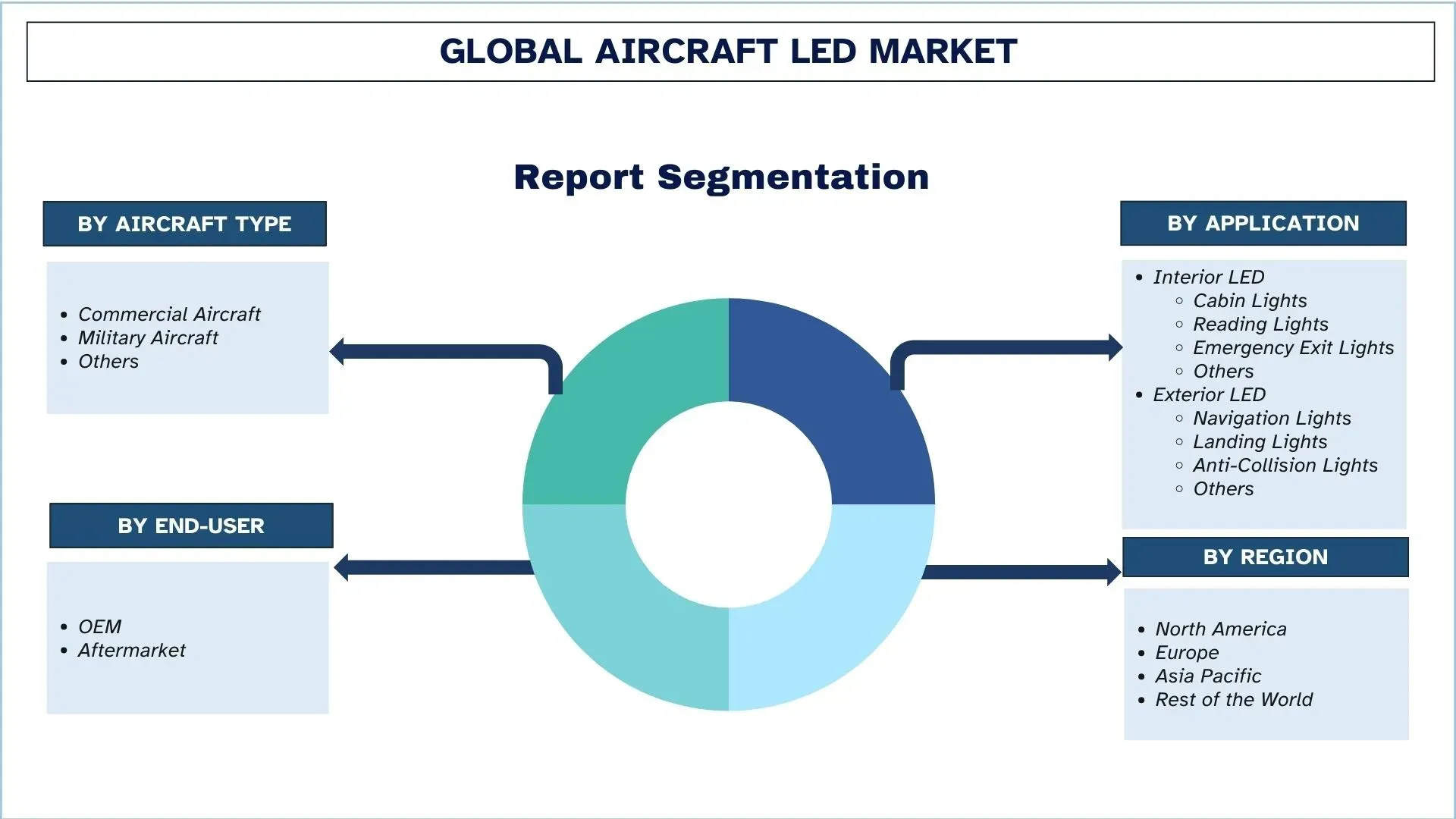
North America is expected to be the significant-growing region
The North American aircraft LED market is developing exceptionally due to the presence of numerous aircraft manufacturers as well as defense contractors. Due to this, advanced LED lighting solutions experience high adoption rates within this region. Additionally, FAA standards and airline fleet updates along with growing aircraft fuel efficiency requirements are fuelling the demand for aircraft LED. The aviation industry brings together commercial flight and military operations which now use energy-efficient and long-lasting smart LED systems to enhance safety standards while decreasing maintenance expenses and creating improved conditions for passengers. Moreover, the aviation industry in the region is experiencing a growing demand for high-performance LED lighting because defense contractors, next-generation aircraft producers, and military forces are actively investing in modern aviation platform development.
Aircraft LED Industry Overview
The aircraft LED market is competitive, with several global and international players. The key players are adopting different growth strategies to enhance their market presence, such as partnerships, agreements, collaborations, new smart LED solutions launches, geographical expansions, and mergers and acquisitions. Some of the major players operating in the market are Honeywell International Inc., Heads Up Technologies, Astronics Corporation, Oxley Group, Beadlight Ltd. (Original BTC Limited), Soderberg Manufacturing Company Inc., Precise Flight Inc., Whelen Aerospace Technologies, Aircraft Lighting International, BaseWest Inc.
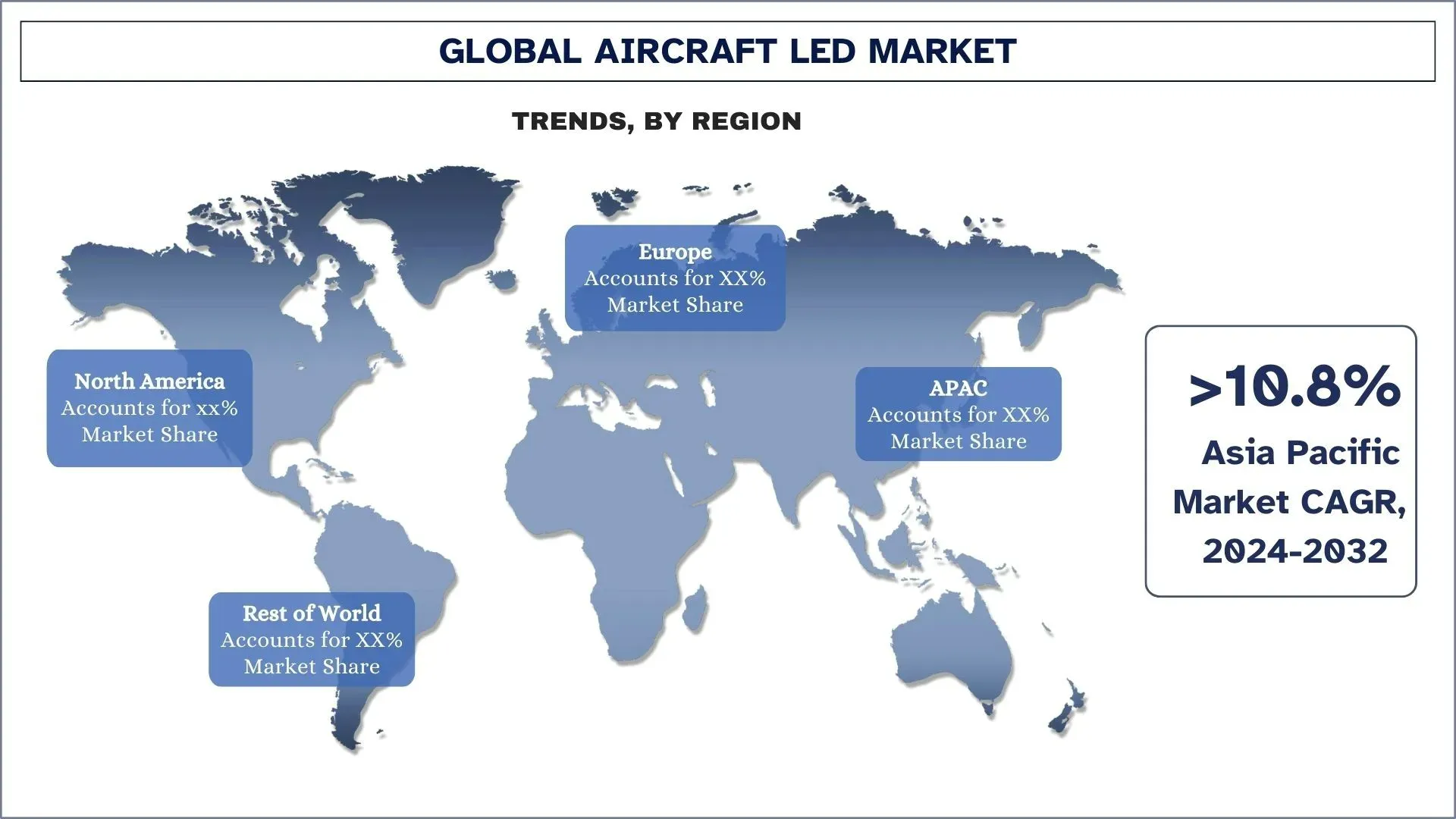
Aircraft LED Market News
In July 2024 – Whelen Aerospace Technologies (WAT), a global leader in aviation lighting, announced the signing of an agreement to acquire substantially all the assets of AeroLEDs, LLC. This strategic acquisition will expand WAT’s product portfolio and solidify its leadership in the aerospace lighting industry.
In October 2023 - Heads Up Technologies, Inc. ("HUT"), a leading provider of highly engineered, proprietary lighting, cockpit, and cabin electronics, announced the acquisition of ALTO Aviation (“ALTO”). Based in Sterling, Massachusetts, ALTO is a leading designer and manufacturer of high-end OEM & aftermarket audio and cabin management systems including LED solutions for the aviation market. This acquisition is expected to enhance the product portfolio of HUT.
In August 2022 - Heads Up Technologies announced the acquisition of STG Aerospace, which is a leading manufacturer of proprietary aircraft cabin lighting products based in Cwmbran, UK, and Miami, FL. This acquisition was done to enhance the aircraft LED solution product portfolio of HUT, as well as to expand its global reach.
Aircraft LED Market Report Coverage
Report Attribute | Details |
Base year | 2023 |
Forecast period | 2024-2032 |
Growth momentum | Accelerate at a CAGR of 9.72% |
Market size 2023 | USD 842.31 million |
Regional analysis | North America, Europe, Asia-Pacific, Rest of the World |
Major contributing region | The Asia-Pacific region is expected to grow at the highest CAGR during the forecasted period. |
Key countries covered | U.S., Canada, Germany, France, UK, Spain, Italy, China, Japan, and India |
Companies profiled | Honeywell International Inc., Heads Up Technologies, Astronics Corporation, Oxley Group, Beadlight Ltd. (Original BTC Limited), Soderberg Manufacturing Company Inc., Precise Flight Inc., Whelen Aerospace Technologies, Aircraft Lighting International, BaseWest Inc. |
Report Scope | Market Trends, Drivers, and Restraints; Revenue Estimation and Forecast; Segmentation Analysis; Demand and Supply Side Analysis; Competitive Landscape; Company Profiling |
Segments Covered | By Aircraft Type, By Application, By End-user, By Region/Country |
Reasons to buy this report:
The study includes market sizing and forecasting analysis validated by authenticated key industry experts.
The report presents a quick review of overall industry performance at one glance.
The report covers an in-depth analysis of prominent industry peers with a primary focus on key business financials, product portfolios, expansion strategies, and recent developments.
Detailed examination of drivers, restraints, key trends, and opportunities prevailing in the industry.
The study comprehensively covers the market across different segments.
Deep dive regional level analysis of the industry.
Customization Options:
The global Aircraft LED market can be customized further as per the requirement or any other market segment. Besides this, UMI understands that you may have your own business needs, hence feel free to connect with us to get a report that completely suits your requirements.
Table of Content
Research Methodology for the Aircraft LED Market Analysis (2022-2032)
Analyzing the historical market, estimating the current market, and forecasting the future market of the global aircraft LED market were the three major steps undertaken to create and analyze the application of aircraft LED in major regions globally. Exhaustive secondary research was conducted to collect the historical market figures and estimate the current market size. Secondly, to validate these insights, numerous findings and assumptions were taken into consideration. Moreover, exhaustive primary interviews were also conducted with industry experts across the value chain of the global aircraft LED market. Post assumption and validation of market numbers through primary interviews, we employed a top-down/bottom-up approach to forecasting the complete market size. Thereafter, market breakdown and data triangulation methods were adopted to estimate and analyze the market size of segments and sub-segments of the industry. Detailed methodology is explained below:
Analysis of Historical Market Size
Step 1: In-Depth Study of Secondary Sources:
A detailed secondary study was conducted to obtain the historical market size of the aircraft LED market through company internal sources such as annual reports & financial statements, performance presentations, press releases, etc., and external sources including journals, news & articles, government publications, competitor publications, sector reports, third-party database, and other credible publications.
Step 2: Market Segmentation:
After obtaining the historical market size of the aircraft LED market, we conducted a detailed secondary analysis to gather historical market insights and share for different segments & sub-segments for major regions. Major segments are included in the report as aircraft type, application, end-user, and regions. Further country-level analyses were conducted to evaluate the overall adoption of aircraft LED in that region.
Step 3: Factor Analysis:
After acquiring the historical market size of different segments and sub-segments, we conducted a detailed factor analysis to estimate the current market size of the aircraft LED market. Further, we conducted factor analysis using dependent and independent variables such as aircraft type, application, end-user, and regions of the aircraft LED market. A thorough analysis was conducted for demand and supply-side scenarios considering top partnerships, mergers and acquisitions, business expansion, and product launches in the aircraft LED market across the globe.
Current Market Size Estimate & Forecast
Current Market Sizing: Based on actionable insights from the above 3 steps, we arrived at the current market size, key players in the global aircraft LED market, and market shares of the segments. All the required percentage shares split, and market breakdowns were determined using the above-mentioned secondary approach and were verified through primary interviews.
Estimation & Forecasting: For market estimation and forecast, weights were assigned to different factors including drivers & trends, restraints, and opportunities available for the stakeholders. After analyzing these factors, relevant forecasting techniques i.e., the top-down/bottom-up approach were applied to arrive at the market forecast for 2032 for different segments and sub-segments across the major markets globally. The research methodology adopted to estimate the market size encompasses:
The industry’s market size, in terms of revenue (USD) and the adoption rate of the aircraft LED market across the major markets domestically.
All percentage shares, splits, and breakdowns of market segments and sub-segments.
Key players in the global aircraft LED market in terms of products offered. Also, the growth strategies adopted by these players to compete in the fast-growing market.
Market Size and Share Validation
Primary Research: In-depth interviews were conducted with the Key Opinion Leaders (KOLs) including Top Level Executives (CXO/VPs, Sales Head, Marketing Head, Operational Head, Regional Head, Country Head, etc.) across major regions. Primary research findings were then summarized, and statistical analysis was performed to prove the stated hypothesis. Inputs from primary research were consolidated with secondary findings, hence turning information into actionable insights.
Split of Primary Participants in Different Regions
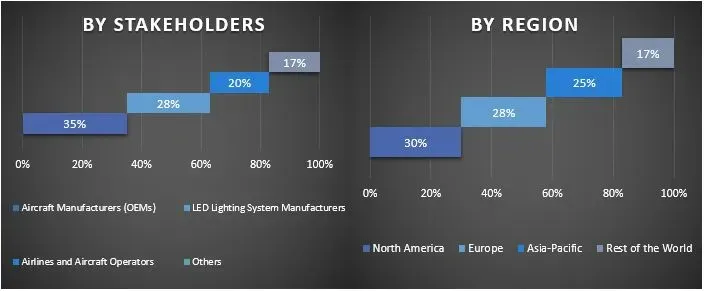
Market Engineering
The data triangulation technique was employed to complete the overall market estimation and to arrive at precise statistical numbers for each segment and sub-segment of the global aircraft LED market. Data was split into several segments and sub-segments after studying various parameters and trends in aircraft type, application, end-user, and regions of the global aircraft LED market.
The main objective of the Global Aircraft LED Market Study
The current & future market trends of the global aircraft LED market were pinpointed in the study. Investors can gain strategic insights to base their discretion for investments on the qualitative and quantitative analysis performed in the study. Current and future market trends determined the overall attractiveness of the market at a regional level, providing a platform for the industrial participant to exploit the untapped market to benefit from a first-mover advantage. Other quantitative goals of the studies include:
Analyze the current and forecast market size of the aircraft LED market in terms of value (USD). Also, analyze the current and forecast market size of different segments and sub-segments.
Segments in the study include areas of aircraft type, application, end-user, and regions.
Define and analyze the regulatory framework for the aircraft LED
Analyze the value chain involved with the presence of various intermediaries, along with analyzing customer and competitor behaviors of the industry.
Analyze the current and forecast market size of the aircraft LED market for the major regions.
Major countries of regions studied in the report include Asia Pacific, Europe, North America, and the Rest of the World.
Company profiles of the aircraft LED market and the growth strategies adopted by the market players to sustain the fast-growing market.
Deep dive regional level analysis of the industry.
Frequently Asked Questions FAQs
Q1: What is the aircraft LED market's current size and growth potential?
The aircraft LED market was valued at USD 842.31 million in 2023 and is expected to grow at a CAGR of 9.72% during the forecast period (2024-2032).
Q2: What are the driving factors for the growth of the aircraft LED market?
The aircraft LED market is majorly driven by increasing demand for energy-efficient and durable lighting solutions, rising aircraft production and fleet modernization, and stringent aviation regulations promoting fuel efficiency.
Q3: Which segment has the largest share of the aircraft LED market by aircraft type?
The commercial aircraft segment has the largest share of the aircraft LED market by aircraft type.
Q4: What are the major trends in the aircraft LED market?
Growing demand for dynamic color-changing LED technology, expansion of OLED (Organic Light-Emitting Diode) and micro-LED display technology as well as increasing application of wireless control systems for aircraft LED are the major trends in the aircraft LED market.
Q5: Which region will dominate the aircraft LED market?
The North America region dominated the market in 2023.
Related Reports
Customers who bought this item also bought





